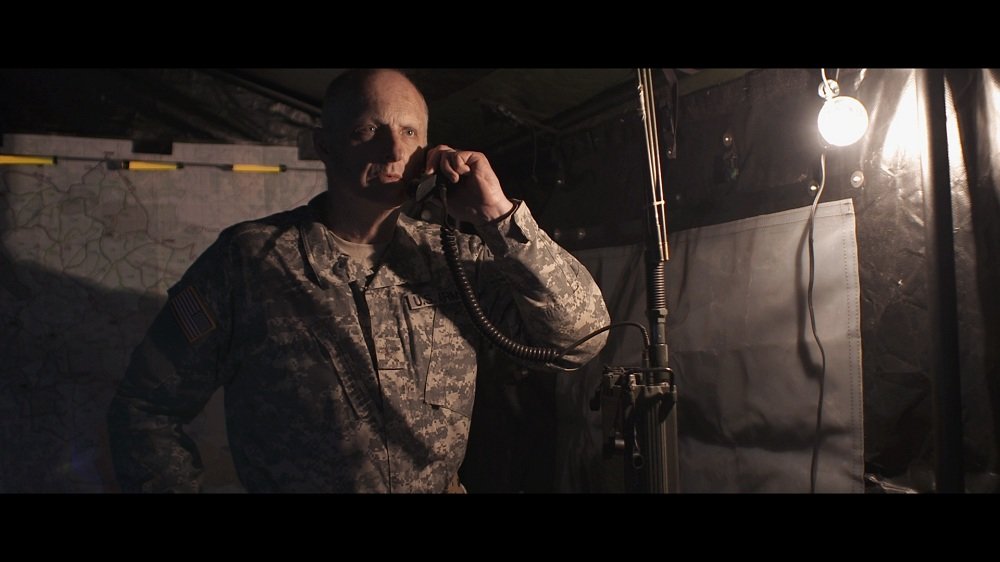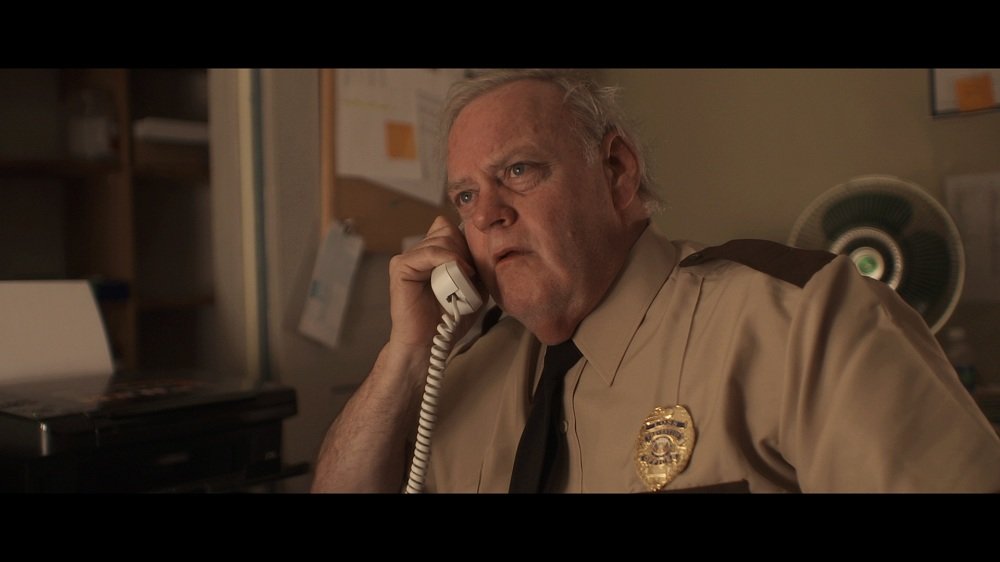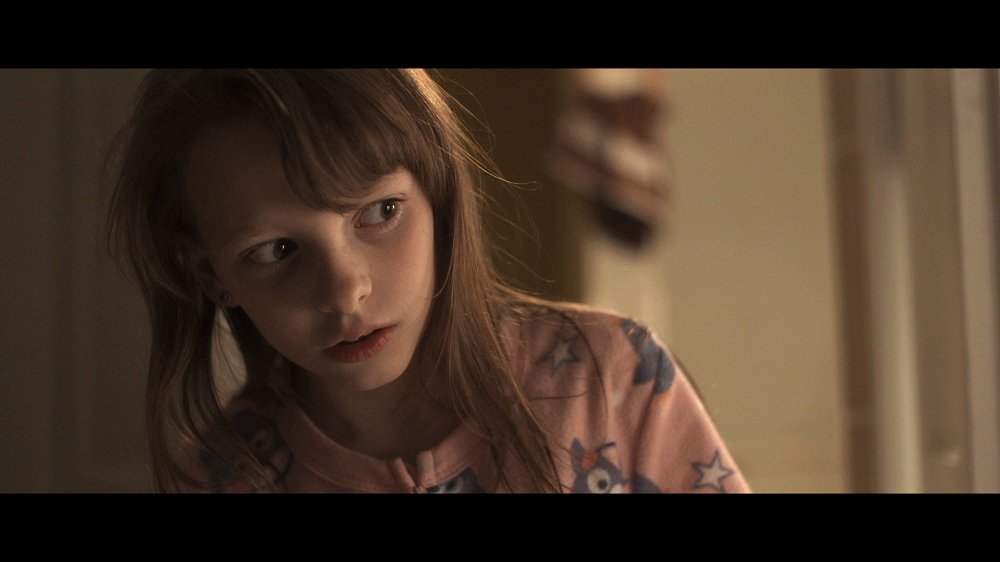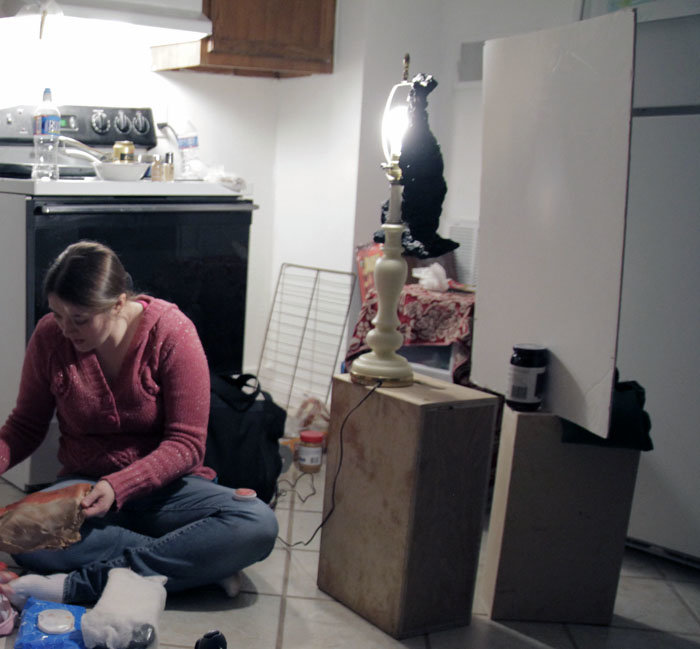
Vincent Sweeney
Premium Member-
Posts
709 -
Joined
-
Last visited
Everything posted by Vincent Sweeney
-
You were kidding, right?
-
Why use these toy cameras anymore? This is why the F3 was built.
-
Plan 9 (from Outer Space!)
Vincent Sweeney replied to Vincent Sweeney's topic in In Production / Behind the Scenes
I enjoy doing shots like this for some reason. This was a real army tent that we had put a single hanging light in. I ended up using a bare 150w bulb on a dimmer and used the 25mm. I thought the light would be appropriate in the frame. This is a very short shot where an army general was shouting a command and it felt right to be a little harsh with the light. I was actually trying for more flare but the old Zeiss held ground. I was surprised at how I could still see part of the bulb while playing with the highlights in the (basic) color grade. I want to thank David Thies at Tvacom for the SS Zeiss prime lens deal and helping us out!! This was an extremely small office (maybe 8x7ft!) in an abandoned church that had to double as a police station office. I used the 25mm for most of the shots here, often out of necessity but also to help add a little space to the room. I used a 200w bulb bounced and a little 55w projection bulb on a dimmer for back-lighting. I kept light sources close to the actors, as if they are desk lamps, and kept the backgrounds darker or shadowed in general. Along with the obvious smallness of the office, I felt this added a subtle effect to the diminishing power the police have in trying to deal with what is coming to their little town. Other shots would show this better but I'm limited in what I can post for now. -
The Tree of Life
Vincent Sweeney replied to Vincent Sweeney's topic in On Screen / Reviews & Observations
Report: Terrence Malick’s “The Tree of Life” took the Palme d’Or Sunday night in Cannes, though the notoriously shy director did not take to the stage to accept the prize. Congrats to all the crew as well!!!! -
Atlanta Crew Needed
Vincent Sweeney replied to Robert John Dubiel's topic in In Production / Behind the Scenes
This is not the correct forum category for this. -
Budget Documentary/ENG Style Rig
Vincent Sweeney replied to Buster Blakeney's topic in General Discussion
Id stay away from the 35mm sensors if you want more of an ENG set-up. You will have headaches with focus that will drive you crazy when you blow up those shots in editing. I agree on the EX3 or 1, great smaller camera with real audio support, unlike a DSLR. -
If anyone asks about digital cine cameras....
Vincent Sweeney replied to Vincent Sweeney's topic in General Discussion
I agree. Imagine Gladiator, There Will be Blood, The Devil's Rejects or The New World being shot digitally; something would be lost for sure. Then again Avatar works better digitally, no doubt. On a related line, check this Wally Pfister interview out: -
If anyone asks about digital cine cameras....
Vincent Sweeney replied to Vincent Sweeney's topic in General Discussion
I think what someone/a production can truly afford is best. I just wrapped an indie feature with an F3 but it would have been on film if more money could have been raised, and because it would have been appropriate for the material. The F3 did very well though. Sometimes it's a question of timing vs. budget vs. need. -
A different direction to consider: Soft, gold light through the window, barely bringing up the room to exposure needed. Don't be afraid of silhouetting/largely back-side lighting at times. This can throw the scene into an even darker place, given the somewhat beautiful light trying to come in while his (hopefully believable) performance opposes it.
-
The Tree of Life
Vincent Sweeney replied to Vincent Sweeney's topic in On Screen / Reviews & Observations
I think anyone professionally involved in film, or wants to be, bothers to find real answers on their own. The rest fade away soon enough. Great article wasn't it? I envy what the crew got to do on this project, and they even got paid for it! What a memory and learning experience. -
The Tree of Life
Vincent Sweeney replied to Vincent Sweeney's topic in On Screen / Reviews & Observations
Again, read the ICG article I posted (any DP or director should). And IMDB is updated by "whomever"; an often inaccurate source to say the least. This one is worth a read too, although it isn't as cinematography related. From Roger Ebert. http://blogs.suntimes.com/ebert/2011/05/a_prayer_beneath_the_tree_of_l.html -
In 2D you will have massive depth. They have, I think, 1/4" chips. I had a class with one and the 3D looked pretty good on the 55" monitors we watched footage on. It was all daylight though so I don't have an opinion on noise.
-
http://vimeo.com/23674221 Send that to them. The Alexa one:
-
The Tree of Life
Vincent Sweeney replied to Vincent Sweeney's topic in On Screen / Reviews & Observations
People report what sells. It was also cheered and applauded, according to several articles. Make a film for the market and it will sort of please most people. Make a film without regard to the ignorant masses and some will absolutely love it, often because it didn't compromise. I prefer to spend my money and time on finding/enjoying the gems. -
The Tree of Life
Vincent Sweeney replied to Vincent Sweeney's topic in On Screen / Reviews & Observations
In 1969, "2001" got plenty of bad reviews too, one popular "critic" even saying it was "amateur filmmaking". How must they feel these days for saying that? -
Plan 9 (from Outer Space!)
Vincent Sweeney replied to Vincent Sweeney's topic in In Production / Behind the Scenes
A little girl walks into a kitchen, trying to find her mom after hearing her scream. I wanted to keep most of the kitchen a little dark but have one light appear to be the source, esp. in the wider shots we did. There was a 100w light bulb over the oven, under an exhaust fan, that served perfectly as a side-back light on her. I laid some 216 over it for this close-up. I then added a 150w blub as a key. This was placed on an apple box with some black-wrap blocking the direct light from hitting her. A small bounce board was placed in front of the exposed side of the bulb making for a nice soft source from about 7 ft away. Again the low light ability of the F3 made this one possible. 35mm, 800+, 2/2.8 I believe. A few people will get a laugh out of that high-tech set up but my lighting help was absent during this shot, probably doing a PA's chore, so I grabbed a jar of jelly to act as a sandbag/clamp to keep the bounce in place. This is the only pic I can find. Obviously the lamp was rotated to give the FX artist some more light during a break. The kitchen was pretty messed up since it was the same one the crew was using to live on. -
New 35mm digital camera from P+S Technik?
Vincent Sweeney replied to Vincent Sweeney's topic in General Discussion
It (Prores option) would be fine for indie features too. I just started doing some quick color passes from "Plan 9", which I shot on the F3 to a KiPro mini on Prores and we are very happy we went this route; so simple and clean. The thing about Cineform is forcing the editing chain to buy it. For small films, it's a hassle and some people don't want to pay out for something they may not use again. This happened when I used the Si2K on one. I think the editor ended up spending a $1000 extra on his personal suite just to keep up. He did really like the quality though. -
This was copied from a fan's blog posting. I don't know his source. In the midst of creating the full breadth of THE TREE OF LIFE, Terrence Malick would put on film some of the most primeval, chaotic and seemingly unknowable moments that have ever percolated in the human imagination. These include the formation of the universe in a stunning blast of cosmic power 14 billion years ago; the formation of Earth from the accretion of solar nebulae 4.5 billion years ago; the appearance of the first single-celled life forms in the Proterozoic Eon; the 160 million years during which dinosaurs reigned as the most dominant and complex beings on the planet; and the universe’s ultimate fate projected billions of years from now when our sun has become a white dwarf and the scattered remnants of Earth trail behind. To create all of this in an authentic way would mean using extensive visual effects for the very first time in Malick’s career. It would also mean doing so with an original approach that would jibe with Malick’s aesthetic sensibilities – mixing Old School paint-and-water effects with the latest in digital generation to find an organic, even emotional, feeling within these seemingly spectacular, mind-boggling events which are of course nature, played out on the screen. Years ago, when the project was still just a seed of an idea in his mind, Malick began consulting with Douglas Trumbull, a pioneer in the inventive use of special effects, most renowned for immersing audiences in outer space for Stanley Kubrick’s masterwork 2001: A SPACE ODDYSEY. Trumbull went on to create effects for Steven Spielberg’s classic CLOSE ENCOUNTERS OF THE THIRD KIND, Ridley Scott’s BLADE RUNNER and the first STAR TREK movie, as well as directing such sci-fi films as SILENT RUNNING and BRAINSTORM. Though he has not worked in Hollywood for years, Trumbull was drawn to Malick’s vision for THE TREE OF LIFE. For one thing, Malick wanted every image to feel like a natural phenomenon, which meant relying as little as possible on computers, and using what Trumbull dubs “Non-Computer Graphics.” “Terry and I share a perspective on visual effects and imagery as it pertains to wanting to get to something that’s completely organic. We both want to push into new territories of what film can actually be. It wasn’t that we didn’t use computers on this film – we used a lot of them and there are some truly amazing computer graphics,” explains Trumbull. “But, for example, when you see the dinosaurs they look like truly living creatures and they are then super-imposed into a world that is completely real. It’s not a synthetic world with a synthetic creature in it. Only 10 to 20 percent of what you’re seeing is computer-generated, but you can’t tell which part of the frame is computer generated and which part is real which fits into Terry’s naturalistic world.” Trumbull had fallen in love with Malick’s naturalism as soon as he saw DAYS OF HEAVEN while he was then working on STAR TREK: THE MOVIE. “I was really impressed that the movie had such a profound effect on my memories. It was a very ethereal, experiential movie that was trying to break the language of cinema,” he observes. “What I like about Terry’s films is that it’s more of a poetic film style. He’s constantly trying to learn something, which is rewarding.” When he read a script for THE TREE OF LIFE, he was overtaken by its creative possibilities. “It takes a simple human story and puts it in the spectacular framework of the beginning and end of the universe and the infinity of life,” Trumbull says. Soon after, Trumbull and Malick began a series of hypothetical conversations about how some of the sequences in Malick’s vision could best be created. “We talked about doing many of the intergalactic effects he wanted the way that we did things many, many years ago -- using water and paint and high-speed cameras,” Trumbull explains. They also talked a lot about astronomy in general, says Trumbull, “about the workings of the universe, the Big Bang Theory, cosmic expansion, general relativity and how they might all fit together. Terry wanted to explore these ideas as an artist, not a scientist, to take film into new territory. He would talk about certain things he wanted to see – protostars [the earliest conglomerations of dust and gas becoming stars], accretion disks [a rotating disc of gas and dust that forms around stars and other massive space objects], the sun turning into a Red Giant [a star in the last stages of its life which has expanded after core collapse] – and we would talk about how it might be done.” Then Trumbull put together a kind of secret laboratory in Austin, Texas, dubbed the “Skunkworks,” where they began to experiment. “We worked with chemicals, paint, fluorescent dyes, smoke, liquids, CO2, flares, spin dishes, fluid dynamics, lighting and high speed photography to see how effective they might be,” he says. “It was a free-wheeling opportunity to explore, something that I have found extraordinarily hard to get in the movie business. Terry didn’t have any preconceived ideas of what something should look like. We did things like pour milk through a funnel into a narrow trough and shoot it with a high-speed camera and folded lens, lighting it carefully and using a frame rate that would give the right kind of flow characteristics to look cosmic, galactic, huge and epic.” To keep the creativity flowing, Malick did not use typical storyboards for these sequences. “He didn’t want a mechanistic approach that would be set in cement,” observes Trumbull. “He would rather have mysterious phenomena spontaneously occur while the camera was rolling.” This process of experimenting and shooting individual effects went on for well over a year. “All along,” says Trumbull, “Malick was hunting for the Tao, that completely unanticipated phenomena, those magical unexpected moments that no one could possibly design.” That hunt proved to be very satisfying. “I’m very proud of how it all worked and all that we discovered,” concludes Trumbull. “I hope the result is a kind of experiential, immersive cinema that goes beyond words and beyond the envelope of a conventional Hollywood movie.” About four years ago, producer Grant Hill also brought in Dan Glass to work in concert with Malick and Trumbull on the high-tech end of the visual effects. The request from Hill took Glass aback, “As a visual effects professional I never imagined I would have the opportunity to work with a filmmaker like Terrence,” he explains. “It was very exciting.” The process was quite different from what he had experienced on some of cinema’s biggest action, fantasy and sci-fi blockbusters, including MATRIX RELOADED and BATMAN BEGINS. “Visual effects are normally very systemized, very planned out at the earliest stages,” he comments, “but Terry was more interested in creating vignettes that really communicate emotion and mood and are more spontaneous feeling.” In keeping with that process, Glass never learned the full story of THE TREE OF LIFE, or anything about the O’Brien family. He was only made aware of the sections of the film tracing the history of the universe, the earth and nature itself. Like Trumbull, he spent a lot of time with Malick discussing what we have gleaned of the history and fate of the universe over billions of years from the latest scientific research. “Terry had read and read and had a phenomenal level of knowledge about our current understanding in these areas,” Glass says. “He had contacted world experts and it was very important to him that in the midst of trying to make beautiful, emotional imagery that it also be representative of the latest scientific theories. As we arrived at ideas and shots, these would be sent to scientists for their input.” Science consultant, Dr. Andrew H. Knoll, Fisher Professor of Natural History at Harvard University, talked with Malick and his team for some years about the history of life and the processes that underpin that history. “What impresses me about Terrence Malick is his deep commitment both to artistic vision and to the facts that inform his film’s philosophy,” says Dr. Knoll. “Terrence worked hard to get the science right, seeing in life’s history the broadest of frames for an intimate family story.” Glass also joined the proceedings at the Skunkworks in Austin, bringing his own assortment of smoke machines, dyes, chemicals and other Old School cinematic tools to add to the mix. “Most contemporary directors would have done these scenes in a very different way. For example, the moment where a meteor hits the earth could be very flashy. But Terry wanted to make it very understated, where you see just the arc of the earth as the shadow of night is crossing over it, and then the meteor hits and the wake is this dispersion of clouds and matter that was created with milk in a circular tank. The result was a very natural, organic feel.” That same kind of organic feel is imbued in recreating the time of the dinosaurs, in which life takes on a fiercer intelligence and perhaps the beginnings of compassion. Glass worked with a lot of filmed material, from redwoods in Northern California to the Atacama Desert in Chile. “Then we would decide where we could place the creatures, almost like an afterthought,” he explains. “We would fit in a creature maybe half framed out of the shot to make it feel more natural. The creatures were chosen to be more understated, not the famous representations of dinosaurs you expect, but more as if you’ve come across a scene from every day life. We worked in close consultation with renowned paleontologist Dr. John “Jack” Horner from Montana State University to keep everything accurate to what we know.” These gaps in human knowledge gave Malick, Glass and Trumbull an open space in which to create. “A lot of what you see in the film is something closer to poetry or painting in the way that it was made,” sums up Glass of the film. “But I think the beauty of that is it allows everyone to draw their own different impressions of what they’re seeing and enjoy it in a personal way.” The great span of natural worlds depicted in THE TREE OF LIFE, from intergalactic movements to rustling trees to domestic moments of love and fear, flow out of the camerawork of four-time Oscar®-nominated cinematographer Emmanuel “Chivo” Lubezki who previously worked with Malick on THE NEW WORLD. As he had done before with Malick, Lubezki focused not at all on typical master shots or coverage, but rather on the sheer expression of emotion through organic images and perpetual motion. He did so by feeling his way into the shots, using natural lighting and handheld cameras, and following the sun, the wind, the trees and his instincts as much as the dialogue or action. “Terry is the most visual director I’ve come across and he and Chivo have a huge amount of trust between them,” says Sarah Green. “They both are driven to use visuals to their fullest extent.” Adds co-producer Nicolas Gonda, “Chivo Lubezki is a vital part of Terry’s process. In a sense he had to be as much a writer as a D.P. because when the two of them are on the set, things can change in the moment. It’s a dance between the two of them riffing creatively off each other.”
-
The Tree of Life
Vincent Sweeney replied to Vincent Sweeney's topic in On Screen / Reviews & Observations
Lubezki interview. Read this from ICG: http://www.icgmagazine.com/wordpress/2011/05/11/sights-unseen/ -
The Tree of Life
Vincent Sweeney replied to Vincent Sweeney's topic in On Screen / Reviews & Observations
Not true at all. The RED crap and the need for fans to feel better about something that doesn't quite hold up to 35mm is really out of control these days. Do your research before posting. -
New 35mm digital camera from P+S Technik?
Vincent Sweeney replied to Vincent Sweeney's topic in General Discussion
Cineform is great but without prores support it'll hurt it. -
It's more that people dont want to trust used film and no one has any money these days. DSLR's are junk so it's hard to enjoy them.. I gave up on that one. ;) Though I just finished a long F3 shoot and actually was impressed. Are you still LA based? We should try to meet up sometime.
-
The Tree of Life
Vincent Sweeney replied to Vincent Sweeney's topic in On Screen / Reviews & Observations
No, The New World didn't make it to IMAX screens. Tree of Life won't either, I'd suspect. It's a huge undertaking for them to market and prep a film for IMAX screenings and this film isn't overly commercial like the (often) junk that makes it in there, which of course is made for the masses outside of the actual IMAX-made films. It's really unfortunate, I'd pay $50 for that ticket. Tree will be the end-of-the-line in cinema quality. -
Just face the fact that you are too limited to do what is asked and take a stand. 8 bit DSLR's with no lights and a toy-like stabilizing device will only go so far. This is why HMI's, Sony F3's, RED's and Stedicam's sell so well.
-
New 35mm digital camera from P+S Technik?
Vincent Sweeney replied to Vincent Sweeney's topic in General Discussion
That's my guess. You have to wonder what "K" they will market this as too, not that it matters much. Their reputation with quality has me interested. I've used the SI2K a couple of times and liked their housing engineering on that one. On thing is for sure, it'll be built like a tank but hopefully close in size to the F3. Hopefully they will have a real demo set up. Cine Gear is always a good time. I ended up bumping into Daniel Pearl, among others, at lunch last time. Now if only the classes weren't so pricey.





